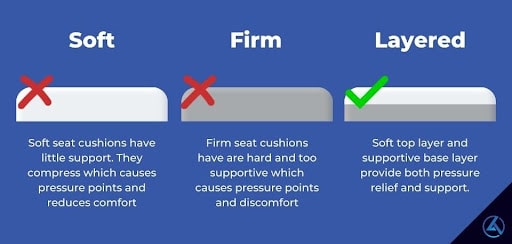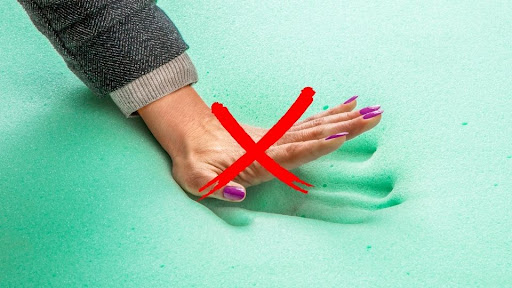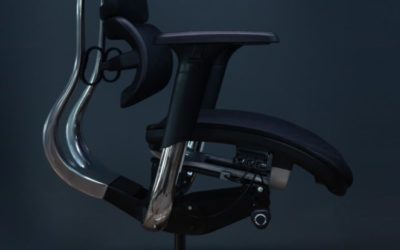
As a general rule, piriformis pain is due to improper sitting posture can cause pinched, irritated, or inflamed nerve roots in the lower spine or pelvis, resulting in sharp, shooting pains in the leg(s). In some positions, such as when lying down to sleep, the pain of piriformis syndrome is worse
This condition is most commonly seen in runners and can cause pain, tingling, and numbness in the buttocks and the leg. While the pain may be worse during activity, it can also often be worse at night. Here we will explore some of the reasons why piriformis pain is worse at night.
In this article, I will give you reasons why piriformis syndrome can cause worse at night, based on my 30 years of advising, treating patients, publishing a book on this topic, speaking on national TV about this, and designing simple solutions (even a successful Kickstarter campaign!):
What is Piriformis Syndrome?
Piriformis syndrome is when the piriformis muscle, a small muscle located deep in the hip, spasms and causes pain in the buttocks. The pain may radiate down the leg and is often worse when sitting or walking. The condition is also known as “pseudo-sciatica” because the pain may be similar to that of sciatica, a condition in which the sciatic nerve is compressed.
Piriformis syndrome is thought to be caused by an inflammation of the piriformis muscle, irritation of the sciatic nerve, or a combination of both. The condition is more common in women and people with tight hip muscles. It is also seen more often in people who participate in sports that involve running and jumping, such as basketball and track.
Treatment for piriformis syndrome typically includes stretches and exercises to loosen the muscle and massage and ice to reduce inflammation. Sometimes, a doctor may prescribe medication or recommend injections to help relieve pain. Surgery is rarely needed.
Why Is Piriformis Pain Worse at Night?

The piriformis is a small muscle located deep in the buttocks. It helps rotate your thigh outwards. The sciatic nerve, the longest nerve in your body, runs underneath the piriformis. When the piriformis muscle tightens or spasms, it can compress and irritate the sciatic nerve causing pain, numbness, and tingling down the back of your leg and into your foot.
Piriformis syndrome is often worse at night because when you lay down, gravity no longer provides counterpressure to prevent the muscle from compressing the sciatic nerve. Bending your knee and pulling your thigh towards your chest can provide some relief by stretching the piriformis muscle.
Best Seat Cushion for Piriformis ComfortDoctor's Recommendation
Black Friday Offer!
Get 35% off Orthopedic Seat Cushion
Product DetailsResearch-based Design
Recommended ForBack Discomfort
Video Guide
Video Guide
Sitting all day in the wrong posture may also produce piriformis pain at night. The piriformis muscle is located in the hip and may get irritated when sitting out of alignment for long hours. The piriformis muscle may also get tight and cause pain when walking or standing.
Other common symptoms of piriformis syndrome include:
– Pain when sitting for long periods
– Pain when walking upstairs or on hills
– Pain that gets worse after prolonged standing or walking
– Difficulty moving your leg or foot due to pain
If you think you may have piriformis syndrome, talk to your doctor. They can diagnose the condition and develop a treatment plan to help relieve your pain.
All Day Comfort & Support
If you are into super easy and inexpensive alternatives to office chairs, I wrote a fantastic article on how and why you should consider these options for back pain, and I encourage you to read it!
Why Piriformis Syndrome Might Be Worse at Night
There are several reasons why piriformis syndrome might be worse at night, including inflammation and muscle spasms. Piriformis syndrome is when the piriformis muscle, a small muscle located deep within the buttocks, spasms and irritates the sciatic nerve. This can cause pain, tingling, and numbness in your buttocks and the back of your leg.
One reason that piriformis syndrome might be worse at night is that when you lie down, the affected muscle can press more firmly against the sciatic nerve. Additionally, the piriformis muscle or sciatic nerve inflammation can worsen at night due to gravity and blood flow patterns. Finally, muscle spasms may be more pronounced since you’re not moving around as much when you’re asleep.
Tips for treating Piriformis Syndrome
People can do a few things to help relieve the symptoms of Piriformis Syndrome. Stretching is one of the best things you can do to help relieve the pain and discomfort from this condition. A heating pad can also help to soothe the muscles and provide some relief. If the pain is severe, over-the-counter or prescription medications may be necessary. In some cases, surgery may be required to correct the problem.
Best Seat Cushion for Piriformis Syndrome

Choosing the right seat cushion is important for comfort and support.
I was surprised how similar cheap memory foam seat cushions were on Aliexpress from the listing on Amazon!
I have extensive experience in treating back pain and can advise on the best seat cushions for comfort and support. I even designed seat cushions for my patients. I explain the concept of my design on a TV show HERE! I can offer some suggestions for managing pressure to address this issue below:
Black Friday: 35% Off Today
Typical Delivery 1-3 Days
Choosing an appropriate cushion for comfort and support

- Pressure Redistribution
Cushions that distribute pressure may prevent pressure points from developing in sensitive areas like hips, tailbones, and thighs, leading to painful buttock pain. A comfortable cushion is one that distributes your weight evenly. A balanced weight distribution can help reduce the risk of back pain.

- Should Improve Posture
Hunching forward is common among people who work at desks. This posture has been linked to many health problems. Many people cannot adjust their posture, so they slouch in their seats. The spine is therefore put under unnecessary strain.

A well-designed seat cushion can help improve posture and keep you comfortable while sitting for long periods. It typically has a firm support base and soft comfort layer, and a non-slip base and covers to keep you in place.
- Temperature control
The problem is that seat cushions are often too hot and uncomfortable because they don’t ventilate properly. Even if your room is kept cooler, your seat may still accumulate and circulate heat.
- The Right Foam
Foam is easy to confuse. Different types of foam have different benefits. Knowing what you want is critical before purchasing foam for seat cushions or other products.
We will discuss their advantages and disadvantages as we learn the differences between latex foam, memory foam, and gel foam.
Gel Foams

Gel/Memory Seat Wedge Foam Combinations (1/5) ☆☆☆☆★
The seat cushion is made of gel-infused memory foam. Our patients found that these pillows lacked the qualities of conforming to the body, providing back support and being cool enough for comfortable use.

Gel Honeycomb Seat Wedge Cushions (3/5) ☆☆★★★
These pillows are made of silicon-based honeycomb foams. Cushions of this type permit air to flow freely and prevent excessive sweating. Silicone may be durable, but it may not be as comfortable, supportive or satisfying as other materials, as it may easily ‘bottom out’ when used, making the cushion uncomfortable.

Memory Foam Seat Wedge Cushions (2/5) ☆☆☆★★
There may be situations where memory foam is appropriate, but not in all cases. Memory foam cushions may not be as comfortable as other cushioning materials if you sit upright or if they are not well-molded to your body, as they react differently to pressure.
Memory foam may not be suitable for posture correction or relieving lower back pain and it may retain heat in warm weather, making it feel warmer. It also contains fire retardants and chemicals and is made from petrochemical materials.

Natural Latex Foam Seat Wedge Cushions (5/5) ★★★★★
You may consider a natural latex ergonomic seat cushion for comfort and support. It allows for a natural alignment of the body and it can also improve blood circulation, helping your spine align effectively. They are also versatile and customizable according to the user’s needs and it does not contain harsh chemicals or agents.
Design of Your Seat Cushion
Core refers to the center of the body. It should be firm, stiff, and stable. Then, it would help us prevent injury from things like back pain to shoulder strain and ensure that all those muscles work together well when exercising or participating in any activity. First, bolster your core with the right seat cushion!
The following features should be considered in a seat cushion for comfort and support:
- Consider buying a seat cushion designed by an expert who has researched the optimal seated positions and materials to relieve back and buttock pain.
- A foam base of the highest destiny is essential!
- The top comfort layer is soft and contoured.
- Ideally, the hips should be higher than the knees for optimal spinal muscle relaxation.
- No toxic substances are present in it.
- Breathable fabric | 4D stretch
- Non-slip bottom.
The Best Way to Sit on the Couch When You Have Piriformis Syndrome
There is no good advice for people with piriformis pain about how to sit on a couch. It would be best to avoid sitting on a couch altogether. Even so, if you sit on your couch, remember that it is like alcohol, which you should consume in moderation.
How to Stop Sciatic Nerve Pain
You can relieve piriformis pain today using the following methods:
- Immediately relieving the sciatic nerve is possible with a combination of warmth and ice. Warm compresses may reduce inflammation and pain, but ice reduces swelling. An ice-heat physiological pump reduces inflammation. In addition, heat or ice may reduce muscle spasms related to sciatica.
- Curcumin, also known as turmeric or turmeric root, is a natural anti-inflammatory.
- If you have sciatica caused by a mechanical issue, you may need the assistance of a chiropractor. The best non-surgical treatment for any nerve root-causing pain is spinal decompression.
- An intense deep-tissue massage enhances the spine’s flexibility by restoring its range of motion. The best non-surgical treatment for any nerve root-causing pain is spinal decompression.
Final Thoughts
If you are experiencing piriformis pain, it is vital to seek medical attention to rule out other potential causes of your symptoms. In the meantime, you can do a few things at home to help manage your pain and promote healing. First and foremost, ensure that you are sitting up straight with good posture, and avoid sitting for long periods. When lying down, place a pillow or rolled-up towel between your knees to keep them from touching. Finally, stay active and continue your regular exercise routine; this will help keep the muscles around the piriformis strong and flexible.
I’ve written a complete hands-on review about the best sitting position for sciatica, and here is what I tested best with my sciatica patients.







